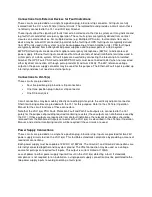
CI-1 Rear
Connections
There are four main interconnection paths to the rear panel:
•
Conections to the fire detection system (CIE)
•
Connections from external devices for fault indications
•
Connections to the LSI-16(e)
•
Power supply connections
Each of these connection paths has several circuits as detailed below.
CIE (Fire Detection System) Connections
Isolated Ground provides a circuit return that is not directly connected to the CI-1 and LSI-16(e) Ground.
Alarm inputs 1 through 4 are signals form the fire detection system. These signals place the Vocia system
into an emergency mode according to the configuration determined for the input in Vocia software. The
Alarm Reset Input cancels all active alarms in the system while the Alarm Silence Input maintains all
active alarms but causes emergency messages to be silenced. The CI-1 provides the necessary
terminating resistors for each input. Inputs are asserted by a positive transition to 12-24V with respect to
the ‘Isolated Ground’ connection. This transition should preferably be derived from a dry contact closure
to a remote 12V-24V source, or to the CI-1 24V Reference Out.
The Voice Alarm Active output is provided to signal to the fire detection system that the Vocia system has
been activated in emergency mode in response to an Alarm Input. A constant output denotes that an
emergency message is playing. A pulsed output (1.25Hz) indicates that an alarm is active but emergency
messages have been silenced.
The General Fault Output is provided to signal to the fire detection system that there is a fault in the Vocia
system that could affect delivery of an emergency message.
The Voice Alarm Active and General Fault outputs pull low (to ground) when active. The outputs are
monitored by the LSI-16(e) for open-circuit or short-circuit to ground or power supply and for over-voltage
on the output pin (>35V DC). If incorrect conditions are detected a Fault is signaled. Output monitoring
facilitates compliance with voice evacuation standards. For monitoring purposes, a load (maximum 22k
Ω
)
must be connected between each output and a positive voltage source referenced to the LSI-16(e)
Ground, at the far end of the connection to the CIE (i.e. at the CIE). An LED indicator connected through
a resistor to a positive voltage at the CIE will suffice as a monitoring load.
Note that the LSI-16(e) provides a 10V source at the '10V Out' terminal on the LSI-16(e). Outputs may be
pulled up at this source; however, the total current drawn from the source must not exceed 100mA. If an
external voltage source is used for the outputs, it must not exceed 35V DC and in addition to the output
loads, must also be connected to the LSI-16(e) ‘External Supply Overvoltage Monitor’ input (refer to LSI-
16(e) User Manual) for monitoring purposes. Due to monitoring constraints, it is not possible to use both
the LSI-16(e) internal 10V source and an external source.
























